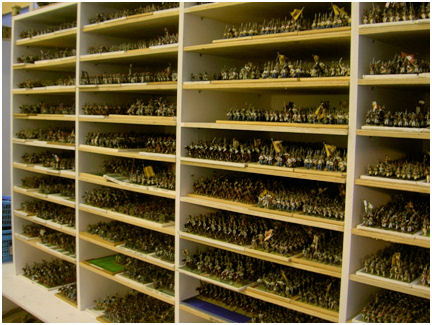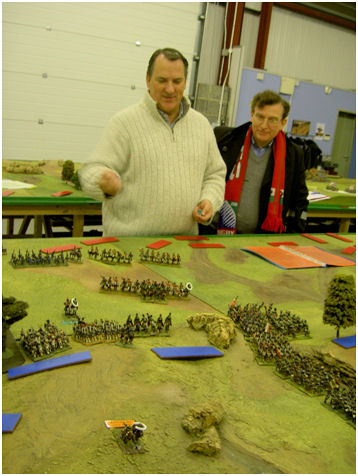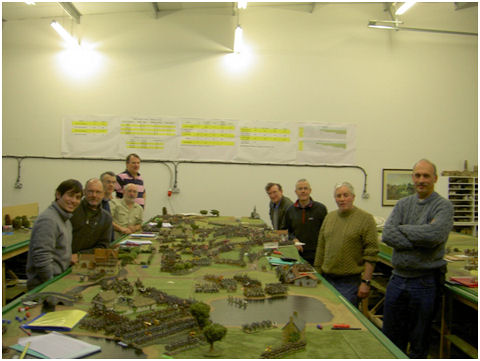|
The Battle of Austerlitz, 1805
Re-Fought at The Holiday Wargames
Centre,
Somewhere in the South of England, 7th
to 9th
December 2012
Rules: In the Grand Manner
By Bill McIntyre
Introduction
The
Holiday
Wargames Centre ("the Centre") is a
dedicated wargaming facility situated deep in the English countryside just
outside the village of
Kingsclere,
several miles from
Basingstoke,
and an hour’s train journey from
Central
London. The Centre stages regular
wargaming events and during a trip to UK I decided to invest a long weekend
at the Centre when it was staging Austerlitz in 25mm Napoleonic figures
using “In
The Grand Manner” as rules. I had
planned to walk part of
The Pilgrim’s Way
that weekend but the cold weather dissuaded me. I made a good choice and had
an excellent weekend’s wargaming.
Further
details of The Centre available on its website:
www.wargameshc.co.uk
The Centre provides the layout (the battlefield is
laid out in three long permanent table sections allowing players to walk
between the sections instead of trying to reach over an impossibly wide
stretch of the battlefield), all the figures, and the rules; and an able
gamemaster
Mark Freeth,
a protégé of the late wargaming legend
Pete
Gilder, directs the set-up and
organization.

The
battlefield of Austerlitz before troop deployment

This is just a
fraction of the figures shelved ready for deployment

This photo
(widened) gives some idea of the scale of the inventory of figures stacked
ready for action
Costs
Cost of a full weekend of gaming for each player
is Sterling Pounds 150.00 (about US$240.00). This includes lunch on Saturday
and Sunday, and coffee/tea and biscuits (USA: cookies) throughout the long
weekend. Participants can travel to The Centre either by car or by public
transport. Trains leave London to either
Newbury
or (more frequently) to
Basingstoke
(about US$30.00 one way), and then by bus (about US$6.00 one way) to the The
Centre which is located at Unit 1-2, Orchard Business Park, Kingsclere
England RG40 4SY (Tel: 01256323332). But don’t do what I did and mistakenly
get off at the wrong bus stop in
Kingsclere
village and take your life in your
hands walking along the A339 Road – there is no pavement (USA: sidewalk) –
but nice scenery though. Or you can drive there - but use a GPS - it is not
in the town.
Hotel Accommodation
Recommended hotel accommodation is the
Hilton
Basingstoke and those without cars
should have no problem hitching a ride to and from this hotel with others
who have driven to the Centre. (One tip though: don’t think you can
negotiate your way back to the hotel in the dark without a GPS – Basingstoke
has a notorious number of similar looking roundabouts (USA: circulars) and
those who are not familiar with that area can easily get confused). A
negotiated rate arranged by The Centre will get you a bed and a real British
breakfast at the Hilton for Sterling Pounds 45 which is less than US$75.00
including tax. There is also a negotiated discount on food and beverages at
the Hilton but bar prices are steep so a local pub is probably a better bet
for the evening strategizing. There is however lots of “scenery” at the bar
of the Hilton…..
The Sides Deploy . . .
The weekend
began on Friday afternoon with players arriving at The Centre by 4pm for a
briefing by gamemaster Mark Freeth on the battle, the timetable for the
weekend and the rules. Also players decided who would play on each side (in
the case of Austerlitz: French or Allies). Team members then allocated units
amongst themselves and began drawing up a strategy for the coming two days.
Deployment was by large coloured (USA: colored) tiles with unit names
written on the back of each tile so that opponents could see that something
was deployed at a particular location but not the actual type of unit. I did
ask the umpire if false or decoy deployments could be used to mislead the
enemy but was advised that would not be allowed for this battle.
The Battle
Following a
hearty British breakfast at the Hilton, players reconvened on Saturday
morning at The Centre for the start of the battle proper. I was a player on
the Allies side. The strategy adopted by the Allies was to:
-
Heavily defend and to hold the Pratzen Heights in the centre at all costs;
-
Hold
the Left Flank where the chances of launching an effective attack were made
extremely difficult by two large frozen lakes with dice-determined penalties
for anyone attempting to cross them, plus a thick wood situated between the
two frozen lakes; I was posted to command this flank.
-
Launch
a rapid all-out Right Flank attack against the French Left Flank. It was
judged that that this French flank would be less able to withstand an
onslaught because so many French troops would already have been committed to
attacking the Centre at the Pratzen Heights. And, the French would probably
have overlooked the risk of an attack against their Left Flank and therefore
not kept a sufficient reserve to shore it up against a tsunami.

In the
above photograph, the French are on the left and the Allies on the right.
The blue and red rectangular tiles represent French and Allied units
respectively which are not yet visible to opposing forces. In the foreground
the two frozen lakes are visible with a thick wood between them. On either
side of the nearest frozen lake, both French and opposing Allies are lining
up to volley fire each other and dissuade each other from making a flanking
move. Meanwhile, in the middle ground the fight for the Pratzen Heights has
not yet started in earnest. And, in the far distance the first flank attacks
by the Allies are beginning to take place.
On the other
side of the left hand frozen lake, I have columns of Austrian units formed
up ready to strike but the question being asked is the wisdom of doing so
because Davout’s cavalry could suddenly arrive on the battlefield and then
the infantry columns would be exposed. This was a continuing source of
discussion between myself and my adjacent fellow Allied commander John and
actually continued throughout the game. One beneficial side effect of this
indecision on my part was to confuse the opposing French commander (also
named John).
On the
back wall large playsheets can be seen depicting movement, firing and morale
tables. The wargaming table you see is as stable as the Rock of Gibraltar –
you could have walked across it without disturbing anything.

“Roll
them dice!” The Allied attack against
the French Left Flank begins. The blue tiles represent French units not yet
visible to advancing Allied forces so there was a calculated risk involved
in advancing. In the background the red tiles represent Allied units
deployed on the Pratzen heights that are not yet visible to the French.
Whenever units came within 12 inches of each other they then became visible
to the opposing units within that range and the tiles were replaced with
figures.
The Star Tavern
Saturday was a long hard fought day and by the end
of the day we were all looking forward to an ale or two at the local tavern.
The nearby
Star Inn
proved an excellent choice for dinner and debrief of the day’s wargaming.
Popular, you are advised to reserve ahead.
(http://www.vintageinn.co.uk/thestarinnkingsclere/).
The Second Day...
Following another hearty British breakfast at the Hilton, Sunday morning saw
the now veterans of Austerlitz reconvening for our final day of shot, charge
and melee.

The
battle begins to consolidate into three distinct sub-battles – in the far
distance the Allies push forward against the French Left Flank, in the
middle the French assault on the Pratzen Heights begins in earnest, and in
the foreground a stalemate develops with the Allies lining up both inside
the heavy wood and along the banks of the nearest frozen lake ready to
repulse any French attempts to advance. Meanwhile, on the other side of the
frozen lake furthest from the photographer, Allied units originally in
column face the French who hold Solkonitz Castle and Chapel of St Anthony,
and The Pheasantry with Davout’s Corps arriving soon. The late arrival of
Davout’s cavalry eventually forced the Austrian columns into squares – yes
they did have some fire effect and some movement but became vulnerable to
French artillery and musket fire. But they were large units and therefore
had an advantage – the question is: “should I have used that advantage to
attack and assault the buildings held by the French to my front?” – although
protected by cover, the French would also have suffered losses and their
smaller size would eventually have made them vulnerable to adverse morale
checks – the smaller a unit the higher its percentage loss from enemy musket
and rifle fire.
And if a unit routs then other units around
it have to test for morale – under In The Grand Manner rules a single rout
can potentially have a serious knock-on effect generating a chain reaction
of bad more results (i.e. poor die rolls) and lead to other units marching
away from the battle.

The French
(nearest the camera) launch an all-out assault on The Pratzen Heights; the
allied Army digs in and slugs it out. They hold.

In the
foreground the Allied Army begins to threaten Solkonitz Castle and the
Pheasantry, in the middle distance the densely packed fight between large
numbers of units from both sides vying for the Pratzen Heights prompts a
ruling from gamemaster Mark Freeth, and in the distant background the Allied
attack on the French Left Flank progressively threatens the entire French
Left Flank.

The final
outcome – the French are repulsed from the Pratzen Heights and are pushed
back on their Left Flank and Solkonitz is threatened, whilst in the
foreground (my command) the Allies suffer heavy losses trying to cross the
nearest lake (I had in fact been advised not to attempt this), but hold
steady on the second lake and continue to hold the thick wood and from
within pour continuous volley fire into the French units forced to protect
themselves from a potential flank attack should I break out from the wood.
On the
second frozen lake you can see a line of skirmishers walking across the ice
to pour fire on formed French troops - an oversight on my part had been not
checking at the beginning of the game to find that skirmishers do not in
fact face the same disadvantages as formed troops face when crossing the
ice; formed troops faced double casualties from enemy fire and each turn on
the ice had to throw a six-sided die and suffer the amount of casualties
shown by the die roll.
Outcome
An Allied
victory.
Concluding remarks
A good solid
weekend's gaming with excellent terrain, excellent figures, and excellent
organization. Yes, I would recommend putting on your "bucket list".
back to
expeditions
|